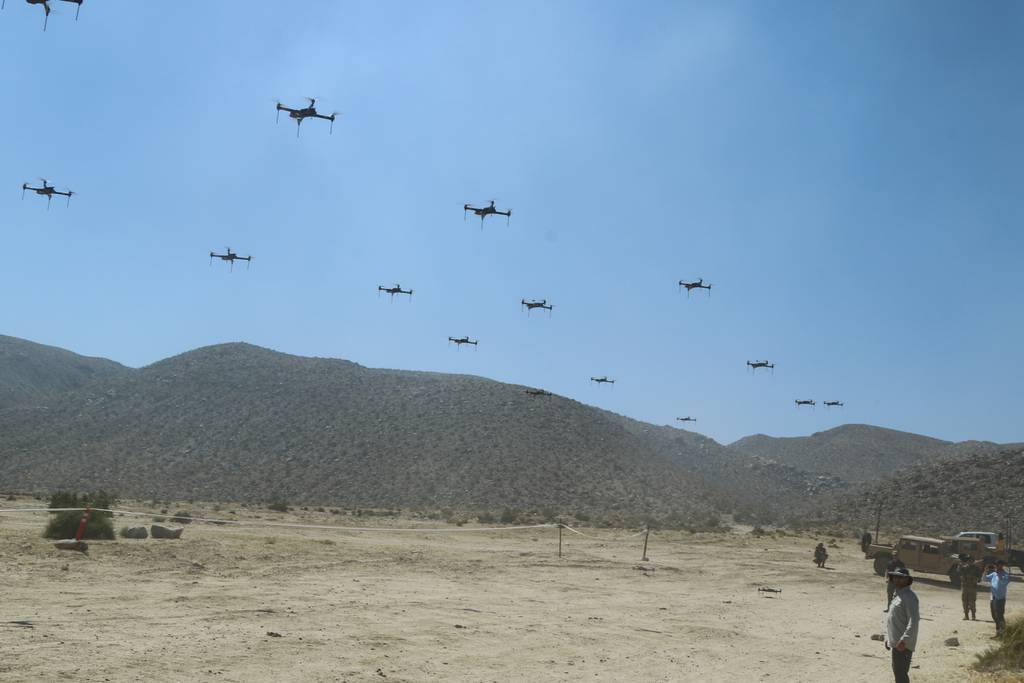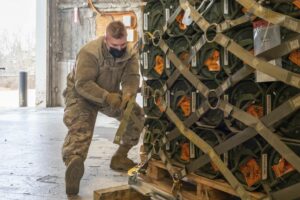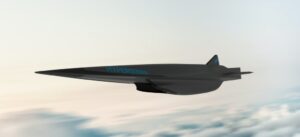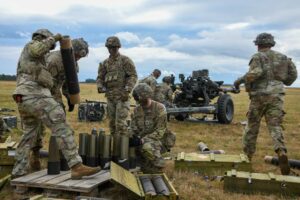
WASHINGTON — As the Pentagon prepares to field thousands of autonomous systems in the coming years, its commercial innovation hub is seeking a modular test platform that it could use to validate payloads, sensors and other technology.
The Defense Innovation Unit wants a system that could be ready for its first flight test within seven months, reach a range of 500 nautical miles (926 kilometers), and deliver a kinetic payload, it said in a Sept. 28 notice.
“The objective is to demonstrate an aerial platform that prioritizes affordability and distributed mass production,” it said. “Multiple vehicle types may be selected for prototyping and multiple variants may be developed following a successful initial flight test. Designs that enable geographically distributed, scalable manufacturing with minimal reliance on specialized tooling and test equipment are preferred.”
The notice comes as the Pentagon embarks on an ambitious plan to change the way it buys high-need capabilities to counter China’s military advantage. Through the first instantiation of the effort, dubbed Replicator, the department wants to significantly scale up production of autonomous systems to deliver thousands of small, attritable platforms across multiple domains over the next 18 to 24 months.
Deputy Defense Secretary Kathleen Hicks announced the effort in late August, saying the plan is to leverage existing programs and, at least initially, existing funding streams.
While not explicitly tied to Replicator, DIU’s solicitation emphasizes the Pentagon’s need for an open-architecture platform that can test, integrate and qualify a range of subsystems and materials without the “exquisite components” and “labor-intensive manufacturing” that slow down existing production processes.
“The Department of Defense replenishment rates for unmanned aerial delivery vehicles are neither capable of meeting surge demand nor achieving affordable mass,” the notice states. “Narrow supply chains, proprietary data and locked designs result in a lengthy timeline to transition new technology into usable capability and limit production and replenishment rates.”
A DIU spokesman did not immediately respond to questions about the effort’s links to Replicator.
Details on how the Pentagon will execute the program have, so far, been slim. The Deputy’s Innovation Steering Group, established in 2021 and co-chaired by Hicks and Vice Chairman of the Joint Chiefs of Staff Adm. Christopher Grady, will oversee Replicator with support from DIU Director Doug Beck.
DISG held a quarterly meeting Sept. 28, and according to Pentagon spokesman Eric Pahon, Replicator was on the agenda.
“The purpose of the inaugural meeting was to ensure familiarization with the initiative across the Pentagon and military services, make clear the tasks and directions for execution, offer an opportunity to ask questions and provide input to support the future direction for Replicator,” Pahon told C4ISRNET in an Oct. 2 statement.
Courtney Albon is C4ISRNET’s space and emerging technology reporter. She has covered the U.S. military since 2012, with a focus on the Air Force and Space Force. She has reported on some of the Defense Department’s most significant acquisition, budget and policy challenges.
- SEO Powered Content & PR Distribution. Get Amplified Today.
- PlatoData.Network Vertical Generative Ai. Empower Yourself. Access Here.
- PlatoAiStream. Web3 Intelligence. Knowledge Amplified. Access Here.
- PlatoESG. Carbon, CleanTech, Energy, Environment, Solar, Waste Management. Access Here.
- PlatoHealth. Biotech and Clinical Trials Intelligence. Access Here.
- Source: https://www.defensenews.com/battlefield-tech/2023/10/03/defense-innovation-unit-seeks-modular-test-system-to-scale-drone-tech/
- :has
- :is
- :not
- $UP
- 10
- 2012
- 2021
- 24
- 28
- 500
- 70
- a
- About
- According
- achieving
- acquisition
- across
- ADvantage
- affordable
- agenda
- AIR
- Air Force
- ambitious
- an
- and
- announced
- ARE
- AS
- ask
- AUGUST
- autonomous
- autonomous systems
- BE
- been
- budget
- Buys
- by
- CAN
- capabilities
- capability
- capable
- chains
- chairman
- challenges
- Chinas
- Christopher
- clear
- comes
- coming
- commercial
- could
- Counter
- covered
- data
- Defense
- deliver
- delivery
- Demand
- demonstrate
- Department
- department of defense
- designs
- developed
- DID
- direction
- directions
- Director
- distributed
- domains
- doug
- down
- drone
- dubbed
- effort
- emerging
- Emerging Technology
- emphasizes
- enable
- ensure
- equipment
- established
- execute
- execution
- existing
- far
- field
- First
- flight
- Focus
- following
- For
- Force
- from
- funding
- future
- geographically
- Group
- Have
- Held
- How
- HTTPS
- Hub
- images
- immediately
- in
- Inaugural
- initial
- initially
- Initiative
- Innovation
- input
- integrate
- into
- IT
- ITS
- joint
- jpg
- Late
- least
- Leverage
- LIMIT
- links
- locked
- make
- manufacturing
- Mass
- materials
- May..
- meeting
- Military
- minimal
- modular
- months
- most
- multiple
- Need
- Neither
- New
- next
- nor
- Notice..
- objective
- Oct
- of
- offer
- on
- Opportunity
- Other
- over
- oversee
- pentagon
- plan
- platform
- Platforms
- plato
- Plato Data Intelligence
- PlatoData
- policy
- preferred
- Prepares
- prioritizes
- Production
- Program
- Programs
- proprietary
- prototyping
- provide
- purpose
- qualify
- Questions
- range
- Rates
- reach
- ready
- reliance
- Reported
- reporter
- Respond
- result
- s
- Said
- saying
- scalable
- Scale
- secretary
- seeking
- Seeks
- selected
- sensors
- sept
- Services
- seven
- she
- significant
- significantly
- since
- slow
- small
- So
- so Far
- solicitation
- some
- Space
- Space Force
- specialized
- Staff
- Statement
- States
- steering
- successful
- supply
- Supply chains
- support
- surge
- system
- Systems
- tasks
- tech
- Technology
- test
- that
- The
- The Future
- The Initiative
- the joint
- thousands
- Through
- Tied
- timeline
- to
- told
- transition
- types
- u.s.
- unit
- usable
- use
- VALIDATE
- vehicle
- Vehicles
- vice
- Vice Chairman
- wants
- was
- Way..
- will
- with
- within
- without
- years
- zephyrnet












